The European Wold Newton Universe
Timeline
(1921-1930)
1921.
Frank Allan goes to Whitechapel and captures "Jack the
Ripper," who has returned to his old neighborhood and begun killing again.
("Die Blutsbrüder von Whitechapel," Frank Allan, der Rächer der
Enterbten #29, 1921). "Jack the Ripper" was apprehended by Sherlock
Holmes in 1888. (Ellery Queen's A Study in Terror). The being who
both Holmes and Ethel King captured in 1912, and who Allan
captured in 1921, was clearly the "Redjac" entity. (see also 1928
below).
The English consulting detective Hannibal Blunt has a successful
year of crimesolving. In some respects similar to Sherlock Holmes,
Blunt is closer in outlook and approach to Sexton Blake. Blunt’s
cases take him around the world; in Germany he fights a brief, hostile
incursion of the same Martians who attacked London in 1898 and who
John Spurlock defeated in 1913. (Adrian Mohr’s Hannibal Blunt,
der Schrecken der Verbrecherwelt #1-50, 1921-1922).
Baron Bunny, a German master thief clearly working in imitation
of Arsène Lupin, makes his debut. (Th. Offenstetten’s Baron
Bunnys Erlebnisse #1-5, 1922, and Baron Bunnys Erlebnisse (film),
1922). It is not known what Lupin’s thoughts were about Bunny.
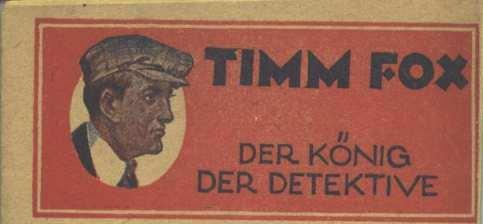 The German detective Timm Fox begins work in Berlin. Although
he solves his share of murders, he also confronts and defeats a number
of fantastic opponents, including a “living holy picture,” a Sudanese vampire,
a cult engaging in human sacrifice, and a group of hostile Martians
(not the same race as the ones of London, 1898). Halfway through the year
he has a friendly competition with Nick Carter. (Timm Fox, der
Konig der Detektiv #1-48, 1921, and Aus den Geheimakten, Eines Weltdetektivs
#1-11, 1921).
The German detective Timm Fox begins work in Berlin. Although
he solves his share of murders, he also confronts and defeats a number
of fantastic opponents, including a “living holy picture,” a Sudanese vampire,
a cult engaging in human sacrifice, and a group of hostile Martians
(not the same race as the ones of London, 1898). Halfway through the year
he has a friendly competition with Nick Carter. (Timm Fox, der
Konig der Detektiv #1-48, 1921, and Aus den Geheimakten, Eines Weltdetektivs
#1-11, 1921).
Fred Gunther, a patriotic German working as a spy for the
Germany government, begins active work. His missions are both espionage
(international) and counter-espionage (domestic), and in one case he defeates
the evil schemes of an American spy. (Gustav Winter’s Fred Gunther's
Abenteuer #1-5, 1921).
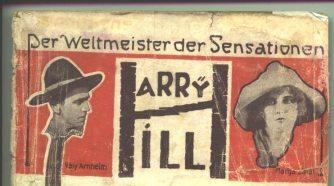 The heroic German adventurer Harry Hill has a good year in
fighting and defeating evil around the world. (Harry Hill, der Weltmeister
der Sensationen #1-27,1921-1922).
The heroic German adventurer Harry Hill has a good year in
fighting and defeating evil around the world. (Harry Hill, der Weltmeister
der Sensationen #1-27,1921-1922).
The German detective Lukas Hull opens his detective agency
in Hamburg. Half of his cases, however, bring him to various locations
across Europe. In one of them he defeats the plot of the evil Japanese
spy Oka-Yuma. (Lukas Hull, Detektiv Abenteuer #1-8, 1921).
This is the third recorded defeat of Oka-Yuma by Western adventurers.
Given the tenor of the Japanese military and intelligence community in
the early 1920s, it is highly likely that Oka-Yuma was recalled to Japan
and either demoted or executed. It is not known who Oka-Yuma’s immediate
successor was, but it is probable that Mr. Moto eventually filled
the role which Oka-Yuma had once held.
A German adventurer leaves India and returns to Germany. In India
the adventurer was given a supernatural aptitude for hypnosis by a group
of fakirs. In Germany the adventurer assumes the pseudonym “Tom
Hypnos” and begins fighting evil, both within Germany and around the
world, from the Pyramids to India. On one occasion he even travels to
Mars, although he never meets the Martians of London, 1898. (Tom
Hypnos, der König der Geheimwissenschaften #1-13, 1921). Although
it is only conjecture, it is quite possible that the fakirs which
empowered “Tom Hypnos” were part of the organization of Mr. Am.
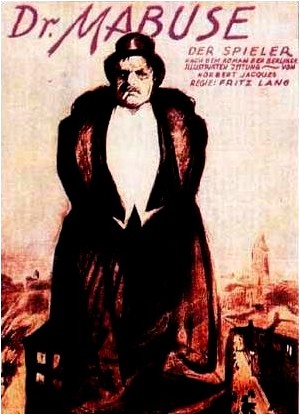 In Berlin the criminal mastermind Dr. Mabuse begins working
toward world domination. He is a psychiatrist who uses his psychiatric knowledge
and abilities at hypnotism (he can also summon visions to control weaker personalities)
and disguise for his own nefarious ends. Among his other operations are counterfeiting
rings, gambling halls, brothels, murder rings, and kidnaping operations.
He is pursued by Police Inspector von Wenk. Mabuse gains his fortune by manipulating
the stock market, ruining the weak Count Told and exploiting Countess Told,
a "debauched thrill-seeking aristocrat." Mabuse also exploits his own girlfriend,
the ballerina Cara Carozza, who is nonetheless slavishly loyal to Mabuse.
Although Mabuse begins as something of an anti-hero, defying a decadent and
corrupt German society, he eventually becomes a thorough-going villain, and
he kills Cara to guarantee her silence (she'd been grilled by Countess Told
earlier but had refused to turn coat), kidnaps and tortures Countess Told,
and kills Count Told. Eventually Mabuse goes insane, haunted by the ghosts
of his victims, and is imprisoned in an asylum. That is not the end for Mabuse,
however.... (Norbert Jacques Dr. Mabuse stories and films, beginning with
Dr. Mabuse, Der Spieler, 1921).
In Berlin the criminal mastermind Dr. Mabuse begins working
toward world domination. He is a psychiatrist who uses his psychiatric knowledge
and abilities at hypnotism (he can also summon visions to control weaker personalities)
and disguise for his own nefarious ends. Among his other operations are counterfeiting
rings, gambling halls, brothels, murder rings, and kidnaping operations.
He is pursued by Police Inspector von Wenk. Mabuse gains his fortune by manipulating
the stock market, ruining the weak Count Told and exploiting Countess Told,
a "debauched thrill-seeking aristocrat." Mabuse also exploits his own girlfriend,
the ballerina Cara Carozza, who is nonetheless slavishly loyal to Mabuse.
Although Mabuse begins as something of an anti-hero, defying a decadent and
corrupt German society, he eventually becomes a thorough-going villain, and
he kills Cara to guarantee her silence (she'd been grilled by Countess Told
earlier but had refused to turn coat), kidnaps and tortures Countess Told,
and kills Count Told. Eventually Mabuse goes insane, haunted by the ghosts
of his victims, and is imprisoned in an asylum. That is not the end for Mabuse,
however.... (Norbert Jacques Dr. Mabuse stories and films, beginning with
Dr. Mabuse, Der Spieler, 1921).
The German adventurer and aviator Phil Morgan begins a years-long
career of successfully fighting evil. Morgan is a pilot, quite similar
to Hans Stark, and travels around the world and even off it. Morgan
is assisted by his two friends, the bear-like Herbert Schranz and the boy
Jean. Together they go everywhere on Earth, from the Yukon to Lake Baikal
to Shanghai, and even venture off-world, exploring comets, the Moon, and
even foreign worlds. Morgan’s vehicle, the Phaenomen-Apparat, is
powered by “Morganite,” a wonder element of Morgan’s creation. The Phaenomen-Apparat
can fly, drive on the land like a car, go underwater like a submarine,
and travel into space. Morgan himself is a heroic engineer/inventor who built
his ship as well as various other technologically-advanced equipment, such
as the "Death Ray," a gun which can anesthetise or kill. Morgan is also
capable of superhuman feats, such as catching bullets with his bare hands.
(Phil Morgan - Der Herr der Welt #1-171, 1921-1922).
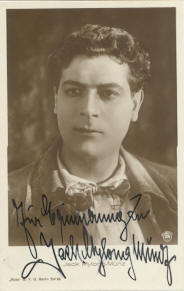 Jack Mylong begins adventuring. He starred in movies under a variety
of names but was known in the German film industry of the 1920s as "Jack
Mylong-Münz." Like Harry Piel, he was a legitimate star in Europe in
the 1920s and 1930s, but unlike Piel Mylong saw the evils of the Nazi regime
and left Germany in 1935, emigrating to the United States. He resumed acting
in 1940 and worked in Hollywood for another twenty years, dying in 1975 at
the age of 83.
Jack Mylong begins adventuring. He starred in movies under a variety
of names but was known in the German film industry of the 1920s as "Jack
Mylong-Münz." Like Harry Piel, he was a legitimate star in Europe in
the 1920s and 1930s, but unlike Piel Mylong saw the evils of the Nazi regime
and left Germany in 1935, emigrating to the United States. He resumed acting
in 1940 and worked in Hollywood for another twenty years, dying in 1975 at
the age of 83.
Like Harry Piel and like Billy Jenkins before him, Mylong
occupied himself with more than just making films. For several years in
the early 1920s Mylong, under the name "Jack Mylong," traveled across Europe,
helping men and women and gaining a name for himself as a daring and heroic
individual. Unlike Harry Piel, however, Mylong did not take Frank Allan or
John Kling as his role model, but rather the slightly sanitized version of
Arsène Lupin which was familiar to most Europeans in the 1920s.
Mylong used a wide variety of disguises in his work, sometimes committing
crimes but always with honorable ends. He became so well-known for his disguises
that he gained the nickname "the adventurous imposter." (Jack Mylong,
Der Abenteuerliche Hochstapler #1-30, 1921-1922). Mylong may have been
one of the “Celluloid Adventurers;” see Note #7.
 The German detective and adventurer Fred Parker begins a
successful career of defending the oppressed against the oppressor wherever
Parker finds them. (Fred Parker, Die Erlebnisse des Großen Unbekannten
#1-152, 1921-1923).
The German detective and adventurer Fred Parker begins a
successful career of defending the oppressed against the oppressor wherever
Parker finds them. (Fred Parker, Die Erlebnisse des Großen Unbekannten
#1-152, 1921-1923).
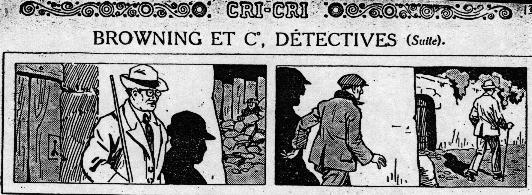 1922. The American detective company Browning
and Co. opens for business, leading to many years of profitable and
successful work. (Jose Moselli’s Browning and Co. stories, beginning in
1922).
1922. The American detective company Browning
and Co. opens for business, leading to many years of profitable and
successful work. (Jose Moselli’s Browning and Co. stories, beginning in
1922).
The German aviator Jim Buffalo begins adventuring. Buffalo
is an aviator whose plane, the “Teufelmaschine” (Devil-machine),
is full of advanced technology, but many of his adventures take on a supernatural
tone, and he becomes known as “Der Mann mit der Teufelswappen”
(The Man with the Devil’s Crest). Early in his career he even receives
the “Testament of Cagliostro.” His adventures took him around the world,
from India to the bottom of the ocean to Syria to San Francisco to the
American prarie to rural Mexico to the swamps of Florida. (Jim Buffalo,
Der Mann mit der Teufelsmaschine #1-29, 1922-1923). It is possible that
Buffalo flew in WW1 for Germany, but there is no record of this.
The German gentleman thief Baronet Duncan becomes active.
Duncan is more than a little influenced by Arsène Lupin,
but unlike Lupin Duncan concentrates his energies on one goal. Duncan and
a rival gang of thieves are competing for a treasure of $218 million, and
this competition, which becomes a violent war, takes Duncan all over the
world, from New York City to Cairo, Hungary, Constantinople, the Carpathian
mountains, India, and Borneo. The first stop in the quest for the money
is London, to the “Steel House Under Baker Street,” where Duncan eludes
“Sherlock Holmes.” (William Harrison’s Baronet Duncan, aus düsteren
kellern und kaschemmen, der Kampf um 218 Millionen #1-38, 1922-1923).
By this time Sherlock Holmes had married Mary Russell, so the bachelor
Holmes portrayed in “Steel House Under Baker Street” could not have been
Sherlock Holmes. It is possible that the “Holmes” who Duncan eluded was
a “Great Detective
Syndrome” sufferer, but it is more likely that the “Holmes”
who pursued Duncan was actually Baker Street’s second-most-famous resident,
Sexton Blake.
Flax, a reporter for a Berlin daily newspaper, begins work.
He uses his position to bust a number of crimes. (Bert Oehlmann’s Reporter
Flax #1-11, 1922).
 The German adventurer Kurt Gafran begins a series of world-spanning
adventures. Gafran’s adventures take him from India to the Sahara to Mexico
to New York City to the Mediterranean to the Rif Desert to Sumatra and
all points in-between. (Kurt Gafrans Reiseabenteuer #1-56, 1922-1932)
The German adventurer Kurt Gafran begins a series of world-spanning
adventures. Gafran’s adventures take him from India to the Sahara to Mexico
to New York City to the Mediterranean to the Rif Desert to Sumatra and
all points in-between. (Kurt Gafrans Reiseabenteuer #1-56, 1922-1932)
The “Great Detective
Syndrome” sufferer Geoffrey Gill begins operating
a consulting detective agency in England. He is assisted by Willem Hendriks
and later by May O’Neill, a female detective who ends up marrying Gill.
(“Ivans”/Jacob van Schevichaven’s Geoffrey Gill novels, beginning with
De Man Uit Frankrijk, 1922).
The German master thief Graf Harras von Kraft begins preying
on the moneyed classes of Europe. Von Kraft’s specialty is targeting
individuals on trains; he makes a habit of stealing shipments of gold
from trains and robbing ministerial couriers. He is particularly skilled
at escapes, being known as the “German champion of escapes.” (Graf
Harras von Kraft #1-8, 1922-1923). It is not known whether von Kraft
and Prince Petroff (who also specialized in robberies on trains)
ever met, although it is quite likely that they would have had some kind
of competition for the same target, either friendly or hostile.
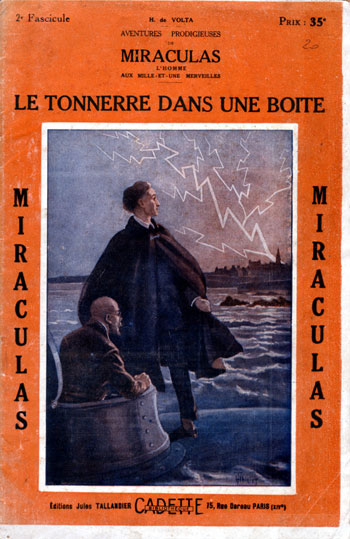 Miraculas, a French inventor-adventurer known as “the man of thousand
and one marvels,” begins a series of fabulous adventures around the world.
Miraculas’ base is an island laboratory on which he creates a range of
advanced technology. Some of his exploits involve a descent into a subterranean
world, the discovery of an undersea city claiming to be “Atlantis,” and
the successful resuscitation of a Neanderthal. (Gabriel Bernard’s Miraculas
#1-20, 1922).
Miraculas, a French inventor-adventurer known as “the man of thousand
and one marvels,” begins a series of fabulous adventures around the world.
Miraculas’ base is an island laboratory on which he creates a range of
advanced technology. Some of his exploits involve a descent into a subterranean
world, the discovery of an undersea city claiming to be “Atlantis,” and
the successful resuscitation of a Neanderthal. (Gabriel Bernard’s Miraculas
#1-20, 1922).
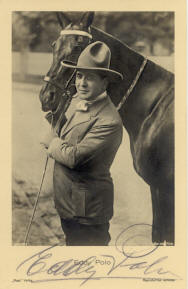 Eddy Polo (1875-1961) begins adventuring. Like Billy Jenkins
and Harry Piel, among others, Polo's career as an adventurer is obscured
or omitted by the mainstream history books. To film historians, Polo is only
an actor, albeit one of the giants of silent film, the "Hercules of the Screen."
He acted widely in the 1910s, although his appearances were more selective
in the 1920s and the arrival of sound in film began the end of his career.
Eddy Polo (1875-1961) begins adventuring. Like Billy Jenkins
and Harry Piel, among others, Polo's career as an adventurer is obscured
or omitted by the mainstream history books. To film historians, Polo is only
an actor, albeit one of the giants of silent film, the "Hercules of the Screen."
He acted widely in the 1910s, although his appearances were more selective
in the 1920s and the arrival of sound in film began the end of his career.
Polo also owned and operated a circus, and it is in this guise that he adventured,
something film historians and biographers conveniently omit from their accounts
of his life. When Polo was not making films, he was touring the world, either
with his circus or by himself, and during these weeks and months he followed
the lead of Jenkins and Piel and made a point of helping innocent men and
women and protecting them from those who would do them harm. (Der Zirkuskönig,
Eddy Polo #1-6, 1922, and Eddy Polo Serie #1-58, 1923-1924).
Polo may have been one of the “Celluloid Adventurers;” see Note #7.
The German-American detective Nic Pratt begins solving crimes in
America and Europe. He takes Nick Carter as his personal model and
hero. (Nic Pratt, Amerikas Meisterdetectiv #1-33, 1922). Several of
Pratt’s adventures have a remarkable resemblance to some of Nick Carter’s
adventures. (See also 1931 below).
A German adventurer leaves India and returns to Germany. In India
the adventurer was given a suite of supernatural powers by a group of
fakirs. In Germany the adventurer, Jens Rolf, begins fighting
crime, both in Germany and around the world. Some of his opponents are merely
human, second-story men and the like, but others are supernatural, from
vampires to haunted houses. (Jens Rolfs Mystisch Abenteuerliche Erlebnisse
#1-10, 1922-1923). (see also 1923 below)
The similarity in origin between Jens Rolf, Tom Hypnos, and Sâr
Dubnotal (among a number of others) has led to previous speculation
that they were all the product of the part of the organization of Mr. Am.
But it is possible that the repeated creation of mystically-powered adventures
of German origin who were sent back to Germany after being given their
powers was an attempt by Mr. Am’s organization to forestall the horrors
of the 1930s, which Mr. Am’s organization might easily have foreseen. Unfortunately,
if this was an attempt by Mr. Am et al. to prevent the rise of German
fascism, it was a complete failure.
The Parisian master criminal Satanas begins spreading fear and chaos.
(Gabriel Bernard's Satanas, 1922).
The master detective Zihni begins work in the streets of
Istanbul. Zihni is clever and resourceful, known and respected as "Fakabasmaz
Zihni" ("Quickwitted Zihni”), and he is so ruthless in his pursuit
of criminals and evil that his methods verge on those of the Master of Terror,
Fantômas. Zihni is, like Fantômas, a master of disguise,
and unlike Fantômas Zihni is never defeated. (Hüseyin Nadir’s
Zihni novels, beginning in 1922).
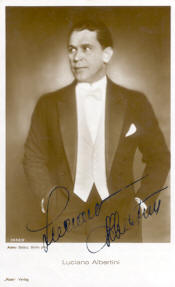 1923. Luciano Albertini (1882-1945) begins adventuring.
Like Harry Piel and a number of other actors and actresses of the
1910s and 1920s, Albertini's career as an adventurer has been omitted by
film historians. Albertini was a legitimate superstar in European film in
the 1910s and 1920s, huge in Italy in the 1920s and then quite popular in
Germany in the 1920s. His career as an actor came to an end with the advent
of sound. But before he retired from film he saved the lives of a number
of men and women in a variety of adventures in quite varied settings. (Luciano
Albertini #1-16, 1923). Albertini may have been one of the “Celluloid
Adventurers;” see Note
#7.
1923. Luciano Albertini (1882-1945) begins adventuring.
Like Harry Piel and a number of other actors and actresses of the
1910s and 1920s, Albertini's career as an adventurer has been omitted by
film historians. Albertini was a legitimate superstar in European film in
the 1910s and 1920s, huge in Italy in the 1920s and then quite popular in
Germany in the 1920s. His career as an actor came to an end with the advent
of sound. But before he retired from film he saved the lives of a number
of men and women in a variety of adventures in quite varied settings. (Luciano
Albertini #1-16, 1923). Albertini may have been one of the “Celluloid
Adventurers;” see Note
#7.
The German adventurer and explorer John Class begins adventuring
around the world. (Reinhold Grosser’s John Class Serie #1-12,
1923-1924).
A man known only as “Fred” is so badly burned by a love affair
that he sells all his effects, abandons his last name (calling himself
only “Fred” and “the pariah of love”) and leaves for a trip around the
world. He finds adventure in a variety of locations and helps a number
of innocent men and women. (Fred ex Voto #1-9, 1923).
The German “Great Detective Syndrome”
sufferer Master King opens a consulting detective agency
in Berlin. His clients’ cases bring him around Europe (Ireland, London,
and Zurich) far more often than they keep him in Germany, and his opponents
tend to be colorful and much more appropriate for Sexton Blake than
for Sherlock Holmes, including a gang of Thugs, “the Murder Clan,”
pirates on the North Sea, “the Satan of London,” “Brill Brillon,” the boss
of the Berlin Underworld, and King’s arch-enemy, Professor Blythe, the “Crime
Genius.” (Master King, der Gentleman-Detektiv #1-25, 1923).
 Todd Marvel begins fighting crime. Marvel is a wealthy amateur detective,
but he takes his crimefighting far more seriously than other, similar individuals
such as Lord Peter Wimsey. Marvel’s arch-enemy is Karl Kristian,
an insane German surgeon who is known as “the King of Transplanting.” (Gustave
LeRouge’s Les Aventures de Todd Marvel, Détective Milliardaire
#1-20 in 1923 and L'Homme Libre, 1924). It is not known whether
Kristian studied under Dr. Caresco or Dr. Cornélius Kramm,
although the similarity between Kristian’s methods and those of Kramm make
some sort of relationship between them likely. However, it is extremely
unlikely that Kramm would have employed any interns.
Todd Marvel begins fighting crime. Marvel is a wealthy amateur detective,
but he takes his crimefighting far more seriously than other, similar individuals
such as Lord Peter Wimsey. Marvel’s arch-enemy is Karl Kristian,
an insane German surgeon who is known as “the King of Transplanting.” (Gustave
LeRouge’s Les Aventures de Todd Marvel, Détective Milliardaire
#1-20 in 1923 and L'Homme Libre, 1924). It is not known whether
Kristian studied under Dr. Caresco or Dr. Cornélius Kramm,
although the similarity between Kristian’s methods and those of Kramm make
some sort of relationship between them likely. However, it is extremely
unlikely that Kramm would have employed any interns.
Benedict Masson is framed for murder and guillotined, only
to have his brain removed from his head and put into the body of an android.
In this body he takes on and defeats a cult of vampires, led by the depraved
and evil Marquis de Coulteray. (Gaston Leroux’s La Poupée Sanglante,
1923, and La Machine a Assassiner, 1924).
Jens Rolf uncovers the horrifying results of Dr. Mors' experiments.
("The Experiment of Doctor Mors," Jens Rolfs Mystisch Abenteuerliche Erlebnisse
#4, 1923). The story of Dr. Mors' escape from English prison after his capture
by Sherlock Holmes in 1906 and Mors' return
to Germany is an untold one. Similarly, it is not known whether Dr. Mors
is related to Captain Mors, although this is doubtful.
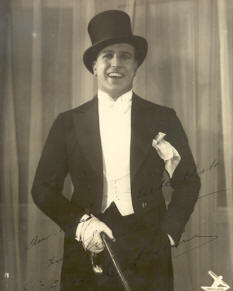 1924. Carlo Aldini begins adventuring. The
Italian Aldini (1894-1961) did not act as widely as some of his predecessors,
but his energy and vigor easily transmitted themselves to the audience, and
Aldini was a star in Italy and Germany in the 1920s. A boxer and champion
wrestler, Aldini put his skills to use when he was not making films, traveling
around the world, hunting tigers, fighting pirates, going after female jewel
thieves, and the like. (Alfred Bienengraber’s Carlo Aldini, der tollkühne
Abenteurer #1-25, 1924). Aldini may have been one of the “Celluloid
Adventurers;” see Note
#7.
1924. Carlo Aldini begins adventuring. The
Italian Aldini (1894-1961) did not act as widely as some of his predecessors,
but his energy and vigor easily transmitted themselves to the audience, and
Aldini was a star in Italy and Germany in the 1920s. A boxer and champion
wrestler, Aldini put his skills to use when he was not making films, traveling
around the world, hunting tigers, fighting pirates, going after female jewel
thieves, and the like. (Alfred Bienengraber’s Carlo Aldini, der tollkühne
Abenteurer #1-25, 1924). Aldini may have been one of the “Celluloid
Adventurers;” see Note
#7.
The German adventurer Sven Berndt begins fighting evil around
the world. (Sven Berndts Phantastische Abenteuer #1-3, 1924).
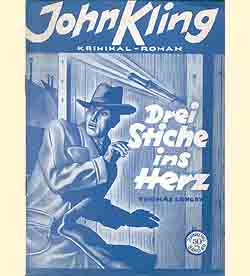 The German master detective John Kling begins his decades-long
career of crimesolving by opening a consulting detective agency in Berlin.
He has certain similarities to Sherlock Holmes, including a Dr.
Watson-like friend, Jones Burthe, but Kling is far too secure in his own
identity to fall prey to the “Great Detective Syndrome”
and even has a long-time lover, Mary, something the misogynist Holmes was
never capable of. Over the course of his long career Kling takes on a
wide variety of enemies, occultists, "Satan," "Madame Satan," pretenders
to operetta kingdoms, and boxing champions; Kling finds a lost kingdom
of Mayans, is appointed King of another European operetta kingdom, investigates
Martian gold (though not the Martians of London, 1898), and encountered
the "Three-Eyed Buddha." (Welt Kriminal Bucherei #1-21, John
Kling's Abenteuer #22-35, Welt Kriminal Bucherei, #36-42, John
Kling's Abenteuer #43-592, 1924-1933 and then 1949-1954, John Kling's
Erinnerungen #1-215, 1931-1939, and John Kling Bucher #1-21,
1937-1939). (see also 1930).
The German master detective John Kling begins his decades-long
career of crimesolving by opening a consulting detective agency in Berlin.
He has certain similarities to Sherlock Holmes, including a Dr.
Watson-like friend, Jones Burthe, but Kling is far too secure in his own
identity to fall prey to the “Great Detective Syndrome”
and even has a long-time lover, Mary, something the misogynist Holmes was
never capable of. Over the course of his long career Kling takes on a
wide variety of enemies, occultists, "Satan," "Madame Satan," pretenders
to operetta kingdoms, and boxing champions; Kling finds a lost kingdom
of Mayans, is appointed King of another European operetta kingdom, investigates
Martian gold (though not the Martians of London, 1898), and encountered
the "Three-Eyed Buddha." (Welt Kriminal Bucherei #1-21, John
Kling's Abenteuer #22-35, Welt Kriminal Bucherei, #36-42, John
Kling's Abenteuer #43-592, 1924-1933 and then 1949-1954, John Kling's
Erinnerungen #1-215, 1931-1939, and John Kling Bucher #1-21,
1937-1939). (see also 1930).
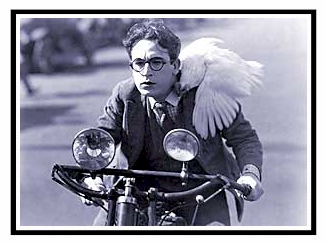 Harold Lloyd begins adventuring. Lloyd (1893-1971) was one of the
two or three most famous stars of the silent era and was a landmark actor
and producer, worthy of comparison with Chaplin and Keaton. Lloyd's films
have weathered the passing of time and are as enjoyable today as they were
when they were first made. Like many other silent film stars, the advent
of sound marked the beginning of the end of his career as an actor. But Lloyd
had a secret, something few knew about: he spent a significant portion of
his personal time fighting crime and evil wherever he found it, both in America
and Europe. Like Harry Piel and several other film stars, Lloyd was
a hero, if not quite on the level of Nick Carter. (Harold Lloyd
#1-5, 1924). Lloyd may have been one of the “Celluloid Adventurers;” see
Note #7.
Harold Lloyd begins adventuring. Lloyd (1893-1971) was one of the
two or three most famous stars of the silent era and was a landmark actor
and producer, worthy of comparison with Chaplin and Keaton. Lloyd's films
have weathered the passing of time and are as enjoyable today as they were
when they were first made. Like many other silent film stars, the advent
of sound marked the beginning of the end of his career as an actor. But Lloyd
had a secret, something few knew about: he spent a significant portion of
his personal time fighting crime and evil wherever he found it, both in America
and Europe. Like Harry Piel and several other film stars, Lloyd was
a hero, if not quite on the level of Nick Carter. (Harold Lloyd
#1-5, 1924). Lloyd may have been one of the “Celluloid Adventurers;” see
Note #7.
 Lee Parry begins adventuring. The German Parry (1901-1977) was born
"Hilde Benz" and began acting in the 1910s. It was only in 1920 that she
became a star in Europe. Like other silent film stars she was not made for
sound, and her star faded in the 1930s, after which she moved to South America
and became a star in theater. However, Parry had a secret: like Harry
Piel and Harold Lloyd, she made use of her spare time to help
others in the most direct way possible: through fighting crime and evil.
More so than most celebrity adventurers, however, she was active around the
world, from Mont-Martre to Upsala to the Rif desert to Whitechapel, and she
fought a variety of unusual opponents, from the Lady In Black to the Smiling
Muslim to the "Death Club," and she made several good friends, including
the Gypsy Princess and the White Knight. (Rosenhain & Hain’s Lee Parry--Die
tollkühne Abenteuerin #1-35, 1924). Parry may have been one of
the “Celluloid Adventurers;” see Note #7.
Lee Parry begins adventuring. The German Parry (1901-1977) was born
"Hilde Benz" and began acting in the 1910s. It was only in 1920 that she
became a star in Europe. Like other silent film stars she was not made for
sound, and her star faded in the 1930s, after which she moved to South America
and became a star in theater. However, Parry had a secret: like Harry
Piel and Harold Lloyd, she made use of her spare time to help
others in the most direct way possible: through fighting crime and evil.
More so than most celebrity adventurers, however, she was active around the
world, from Mont-Martre to Upsala to the Rif desert to Whitechapel, and she
fought a variety of unusual opponents, from the Lady In Black to the Smiling
Muslim to the "Death Club," and she made several good friends, including
the Gypsy Princess and the White Knight. (Rosenhain & Hain’s Lee Parry--Die
tollkühne Abenteuerin #1-35, 1924). Parry may have been one of
the “Celluloid Adventurers;” see Note #7.
The American inventor Joe West begins a series of fantastic
adventures. He is an inventor, working in (conscious or unconscious) imitation
of Thomas Edison, who uses the miraculous new invention of radio
as a springboard not just for adventures but for further inventions, advanced
airplanes, submersible ships, robots, and the like. West and his assistant
Albin adventured around the world, using their fantastic new inventions
to fight for good. (Im Radio Club, Aus Dem Tagebuch des Ingenieurs
West #1-24, 1924-1925).
1925. Belphegor,
the black-clad "ghost of the Louvre," operates in the hidden parts of the
Louvre as a puppet of a Rosicrucian sect. He is eventually stopped with the
help of Chantecoq. (Arthur Bernède's The Phantom of the Louvre,
1927).
The Chinese master thief who calls himself “Lu Ping” begins a correspondence
with Arsène Lupin. Lupin is encouraging to the Shanghai-based
Lu Ping, who is successful immediately and becomes known as the "Oriental
Arsène Lupin.” (Sun Liaohong’s Lu Ping stories, beginning in 1925).
In a coincidental repetiation of the Lupin-Sherlock Holmes duels
of two decades before, Lu Ping repeatedly jousts with Huo Sang, “the
Oriental Sherlock Holmes,” who has (like Lu Ping) corresponded with his
Western counterpart and received encouragement and advice from him. (Cheng
Xiaoqing’s Huo Sang stories, beginning with “Dengguang renying,” 1914).
The Indian (Asian) detective Rama Singh opens a consulting detective
agency in Delhi. He is primarily active in India but also travels during
cases to Burma, Ceylon, and Mecca. (Fritz Lange’s Rama Singh - Indische
Kriminalromane #1-11, 1925). It is quite possible Rama Singh was one
of the Asian agents of the organization of Mr. Am.
1926. Pierre d’Artois,
a French occult detective, begins work in the haunted city of Bayonne,
on the border of France and Spain. On occasion d’Artois works with the
American adventurer Glenn Farrell and Arabian scholar Ishmeddin.
(E. Hoffman Price’s Pierre d’Artois stories, beginning with “The Word of
Santiago,” 1926).
A nameless French aviator, only a teenager, begins a series
of adventures around the world. (Arnould Galopin’s Un Aviateur de
15 Ans #1-99, 1926-1928).
The portly Parisian police officer Saturnin Dax begins work.
Over the years he rises from poverty to the rank of Special Commissaire
of Paris' Judicial Police. (Marten Cumberland’s Saturnin Dax novels,
beginning with The Perilous Way, 1926).
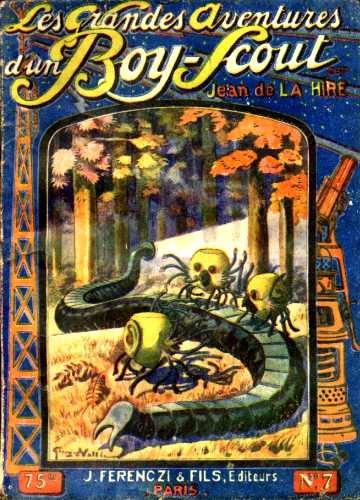 The adventurous French Boy Scout Franc-Hardi begins a world-spanning
series of his adventures on the "radio plane" of the inventor-engineer
Korridès. (Jean de la Hire’s Les Grandes Aventures d'un
Boy-Scout #1-18, 1926).
The adventurous French Boy Scout Franc-Hardi begins a world-spanning
series of his adventures on the "radio plane" of the inventor-engineer
Korridès. (Jean de la Hire’s Les Grandes Aventures d'un
Boy-Scout #1-18, 1926).
The Turkish police detective Meşhedi begins working the mean
streets of Istanbul. (Ercüment Ekrem Talu’s Meşhedi novels, beginning
with Meshedî'nin hikâyeleri, 1926).
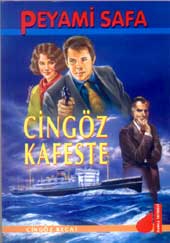 The Turkish detective known as “Recai” begins a decades-long
career of independent crimesolving in Turkey and Europe. Known as “Cingöz
Recai” (“Wily Recai”), Recai is a cunning and devious detective influenced
in some respects by Arsène Lupin. Recai is a master of disguise,
full of Lupin's joie de vivre and good humour, and he does things as
much for the thrill of the chase as for any desire for justice. (“Server
Bedi”/Peyami Safa’s Recai novles, beginning with Alnimin kara yazisi
: roman, 1926). (see also 1940 below).
The Turkish detective known as “Recai” begins a decades-long
career of independent crimesolving in Turkey and Europe. Known as “Cingöz
Recai” (“Wily Recai”), Recai is a cunning and devious detective influenced
in some respects by Arsène Lupin. Recai is a master of disguise,
full of Lupin's joie de vivre and good humour, and he does things as
much for the thrill of the chase as for any desire for justice. (“Server
Bedi”/Peyami Safa’s Recai novles, beginning with Alnimin kara yazisi
: roman, 1926). (see also 1940 below).
The Swedish psychoanalyst and amateur detective Dr. Zimmertür
begins solving crimes in Stockholm. The Jewish Zimmertür applies
the methods taught to him by Mycroft Holmes himself and has a successful
career as a crimesolver for several years despite his personal eccentricities.
(Frank Heller’s Dr. Zimmertür novels, beginning with Doktor Z,
1926).
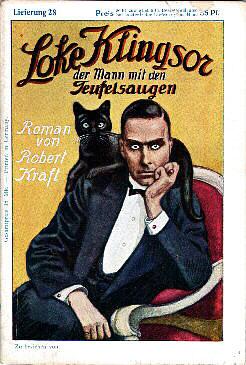 1927. The mesmerist Loke Klingsor begins his criminal
career in Berlin. Known as “the Man With the Devil’s Eyes,” Klingsor clearly
models himself on Dr. Nikola but is not as successful as Nikola. (Robert
Kraft’s Loke Klingsor, Der Mann mit der Teufelsagen, 1927). It is not
known what relationship, if any, lies between Klingsor and Nikola.
1927. The mesmerist Loke Klingsor begins his criminal
career in Berlin. Known as “the Man With the Devil’s Eyes,” Klingsor clearly
models himself on Dr. Nikola but is not as successful as Nikola. (Robert
Kraft’s Loke Klingsor, Der Mann mit der Teufelsagen, 1927). It is not
known what relationship, if any, lies between Klingsor and Nikola.
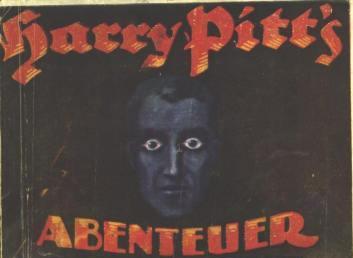 The German adventurer Harry Pitt begins fighting crime around the
world, combating masked crime leaders and Satanic cults in the United States,
England, and Europe. (Harry Pitt's Abenteuer #1-25, 1927).
The German adventurer Harry Pitt begins fighting crime around the
world, combating masked crime leaders and Satanic cults in the United States,
England, and Europe. (Harry Pitt's Abenteuer #1-25, 1927).
The supercriminal and master thief Rafferty begins an orgy of theft
across the United States. He and his gang work on a grand scale, plotting
and executing the robberies of banks that carry $20 million and robbing entire
city blocks worth of stores. He robs casinos, emptying them completely; he
cleans out a museum, just to decorate his underground hideout. He kidnapped
twenty young socialite debutantes and held them ransom for five million each.
Of course, because Rafferty is a gentleman, he does not follow through on
either his threats or his ransom gathering, instead letting the young ladies
go free, because no gentleman will prey on a lady. He is pursued by the venal
and corrupt Bradley, the head of the 3400 detective agency, and is assisted
by the German inventor known as “Herr Heinie.” (A.E. Apple’s Rafferty
stories, beginning with “Rafferty, Master Rogue,” 1927).
Lady Diana Wyndham, the beautiful, free-spirited British woman who
is known as the "Madonna of the Sleeping Cars" because of the many thousands
of miles she has traveled on the railroads of the Continent, becomes involved
with Varichkine, a Soviet agent, during her attempt to recover her
fortune. (Maurice Dekobra’s The Madonna of the Sleeping Cars, 1927).
1928. Sexton Blake
goes in pursuit of "Jack the Ripper," eventually capturing him.
He discovers that "Jack" survives and flourishes by changing his identity
and stealing the "life-force" of his victims. ("Anthony Skene"/George Norman
Philips' The Ripper Returns, 1948). "Jack the Ripper" was apprehended
by Sherlock Holmes in 1888. (Ellery Queen's A Study in Terror).
But he reappeared a number of times after his capture and death. In all
cases the being committing the murders was the "Redjac" entity. Only
Blake came closest to discovering the truth about "Redjac," but even he
did not discover everything about the creature--or, alternatively, the truth
was too horrible to disclose to the English public, and Blake and his biographer
Philips agreed to obscure the truth.
The patriotic German adventurer J. Halifax begins solving crimes
while also operating as a counterespionage agent and helping the German government
to protect state secrets. (Die Abenteuer des J. Halifax #1-3, 1928).
The Czech police Detective Captain Doctor Mejzlik comes to the public’s
attention in Prague. He is an ordinary man, somewhat hot-tempered, who as
a member of the Prague police force has to deal with a wide variety of crimes
and criminals, none of which are particularly brutal but several of which
are quite puzzling. Dr. Mejzlik is a down-to-earth and fairly realistic character,
as is the milieu he lives and works in and the crimes and criminals he deals
with. (Karel Capek’s Dr. Mejzlik stories, beginning in 1928).
The French spy and adventurer James Nobody (I) begins working France
as a counterespionage agent. (Les Merveilleux Exploits de James Nobody
#1-11, 1928-1929).
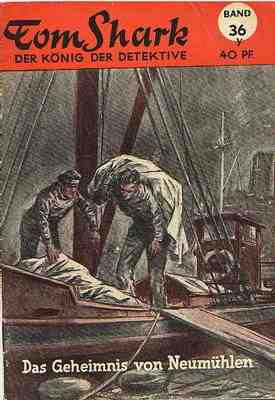 The great German detective Tom Shark begins a decades-long career
as the “King of Detectives.” Shark is successful both in Germany and Europe
and the rest of the world, solving both ordinary crimes and unusual and even
supernatural wickedness. His opponents range from ordinary, tawdry murderers
to villains the like of which Sexton Blake fought, from mad scientists
to master criminals. His activities during World War Two are unknown, although
it is assumed that he served in the German army, but after the war ended he
resumed work as a private detective in Berlin. (“Pitt Strong”/Elisabeth von
Aspern’s Tom Shark, der König der Detektivs #1-553, 1928-1939,
and #1-60, 1945-1951).
The great German detective Tom Shark begins a decades-long career
as the “King of Detectives.” Shark is successful both in Germany and Europe
and the rest of the world, solving both ordinary crimes and unusual and even
supernatural wickedness. His opponents range from ordinary, tawdry murderers
to villains the like of which Sexton Blake fought, from mad scientists
to master criminals. His activities during World War Two are unknown, although
it is assumed that he served in the German army, but after the war ended he
resumed work as a private detective in Berlin. (“Pitt Strong”/Elisabeth von
Aspern’s Tom Shark, der König der Detektivs #1-553, 1928-1939,
and #1-60, 1945-1951).
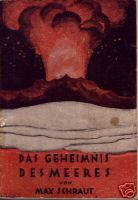 1929. The Swedish adventurer Olaf Karl Abelsen is
convicted of a crime he did not commit. He immediately escapes from prison
and goes on the run, fighting for justice both across Scandinavia and around
the run, accompanied by only one companion, his dog. His adventures quickly
become fantastic in scope, from the supernatural to the science fictional.
(“Max Schraut”/Walther Kabel’s Olaf K. Abelsen - Abseits der Alltagswege
#1-50, 1929-1933). (see also 1933 below).
1929. The Swedish adventurer Olaf Karl Abelsen is
convicted of a crime he did not commit. He immediately escapes from prison
and goes on the run, fighting for justice both across Scandinavia and around
the run, accompanied by only one companion, his dog. His adventures quickly
become fantastic in scope, from the supernatural to the science fictional.
(“Max Schraut”/Walther Kabel’s Olaf K. Abelsen - Abseits der Alltagswege
#1-50, 1929-1933). (see also 1933 below).
Frank Allan, in Paris, is assisted on a case by Charles Dupin,
a detective. (Frank Allan, der Rächer der Enterbten #469, 1929).
C. Auguste Dupin is not known to have any relatives, but given Charles
Dupin's last name and profession, it is quite possible that he is related
to the illustrious Chevalier Dupin by blood.
Later in the year Frank Allan twice clashes with Captain Mors.
(Frank Allan, der Rächer der Enterbten #472 & #491).
The German detective John Baxter begins a career of fighting exotic
criminals and evils around the world, from cannibals in Melanesia to vampires
in Transylvania. (John Baxter der Detektiv #1-50, 1929-1932). (see
also 1931 below).
Harald Harst applies to join the New Eccentric Club. When
he discovers the restrictive acceptance standards–the necessity to solve
a set number of cases–he regretfully withdraws his application. (New Eccentric
Club, 1929).
The Norwegian “Great Detective
Syndrome” sufferer Charles Holm begins solving crimes
in Norway, assisted by his friend Dr. Madsen. (Robert Storm Petersen’s Charles
Holm novels, beginning with Holm og Madsen, 1929).
The French scientist Konserson begins kidnaping children and surgically
transforming them into gnomes with hypertrophied brains, toward the end of
taking possession of a death ray which will allow him to take control of a
throne in Asia. (André Falcoz’s La Poudre de Mort, 1929).
Monte Carlo is the scene of an extended duel between the British superspy
James Nobody (II) and Véra Roudine, a terrorist working
for Cheka, the Soviet secret police. (Charles Lucieto’s The Mystery
of Monte Carlo, 1929).
The Soviet inventor Fédor Ivanovitch Sarraskine uses his science
to create a supersubmarine which he uses to attack British and American shipping
and their fleets, as well as using mad science to surgically alter his victims
and turn them into fish-men who are forced to obey his commands. (Jose Moselli’s
La Guerre des Océans, 1929). Sarraskine has some similarity
to Captain Nemo, but what relationship, if any, lies between them is
unknown.
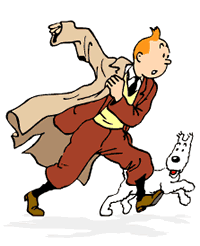 Tintin, a teenaged Belgian, begins a decades-long career of extraordinary
exploits. He works as a reporter for Le Petit Vingtieme, traveling
around the world in pursuit of stories. He usually gets involved in the stories
he reports on, helping people and seeing that the wicked and criminal are
punished. He goes everywhere, from America, to the Congo, the Mediterranean,
Egypt, India, South America, Scotland, Tibet, and the moon itself. He is accompanied
by his faithful dog, the fox terrier Milou (who speaks to the reader), Dupont
and Dupond, a mustachioed pair of French detectives, Captain Haddock, a strong,
alcoholic sea captain, and Professor Tournesol, the deaf, dithery, eccentric
(but brilliant) scientist, whose inventions (a new white rose, an anti-alcohol
tablet, a mini-sub, a moon rocket, an "ultra-sound emitter," and high-speed
roller skates) enrich Tintin enough that he, Haddock, and Milou are able
to move in to a castle together. ("Hergé"/Georges Remi's Tintin stories,
beginning with Tintin aux Pays des Soviets, 1929).
Tintin, a teenaged Belgian, begins a decades-long career of extraordinary
exploits. He works as a reporter for Le Petit Vingtieme, traveling
around the world in pursuit of stories. He usually gets involved in the stories
he reports on, helping people and seeing that the wicked and criminal are
punished. He goes everywhere, from America, to the Congo, the Mediterranean,
Egypt, India, South America, Scotland, Tibet, and the moon itself. He is accompanied
by his faithful dog, the fox terrier Milou (who speaks to the reader), Dupont
and Dupond, a mustachioed pair of French detectives, Captain Haddock, a strong,
alcoholic sea captain, and Professor Tournesol, the deaf, dithery, eccentric
(but brilliant) scientist, whose inventions (a new white rose, an anti-alcohol
tablet, a mini-sub, a moon rocket, an "ultra-sound emitter," and high-speed
roller skates) enrich Tintin enough that he, Haddock, and Milou are able
to move in to a castle together. ("Hergé"/Georges Remi's Tintin stories,
beginning with Tintin aux Pays des Soviets, 1929).
The French-Canadian detective Valcour joins the New York City Police
Department. Over the next few decades he has an extremely successful career,
rising to the rank of Inspector. Valcour takes a more subtle approach to crime-solving
than most American detectives, being influenced by his French father, a former
Parisian policeman; he plays on a suspect's emotions, although as he grows
older he pays more attention to clues and logic and less attention to intuition.
He is quiet, polite, smart, and unswayed by the upper classes among whom
he usually works. (Rufus King’s Valcour novels, beginning with Murder
by the Clock, 1929).
1930. The Dutch gentleman
detective Mynheer Amayat begins solving crimes in Holland and across
Europe. (H. De Vere Stacpoole’s The Tales of Mynheer Amayat, 1930).
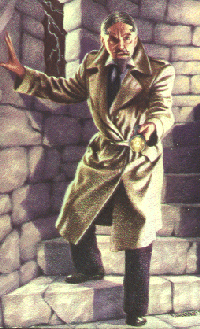 The eccentric dandy and juge d’instruction for the Paris police Henri
Bencolin comes to the public’s attention. Though a police officer Bencolin
often works on the side as a private investigator, charging exorbitant fees
that are greater than his official salary. He is very flamboyant and a regular
at certain nightclubs, where he is regularly seen drinking beer, smoking cigars,
and listening to jazz from a corner table. More importantly, though, he is
known as the “foremost police official in Europe and as the “most dangerous
man in Europe.” It is widely said about him that when he is looking only for
pleasure, he wears a plain sack suit. When he is thinking about a case he
is working on, he wears a dinner jacket. But when he has found the culprit
and is about to capture him or her, Bencolin wears evening clothes and carries
his walking stick with the silver head, inside of which is concealed a sword
blade. This story is true. Bencolin encourages his Watson, a young journalist
named Jeff Marle, to spread this story. Bencolin is known, with good reason,
as "Mephistopheles smoking a cigar," and though often challenged by his old
rival, the German Baron Sigismund von Arnheim, also triumphs. (John Dickson
Carr’s Henri Bencolin novels, beginning with It Walks By Night, 1930).
The eccentric dandy and juge d’instruction for the Paris police Henri
Bencolin comes to the public’s attention. Though a police officer Bencolin
often works on the side as a private investigator, charging exorbitant fees
that are greater than his official salary. He is very flamboyant and a regular
at certain nightclubs, where he is regularly seen drinking beer, smoking cigars,
and listening to jazz from a corner table. More importantly, though, he is
known as the “foremost police official in Europe and as the “most dangerous
man in Europe.” It is widely said about him that when he is looking only for
pleasure, he wears a plain sack suit. When he is thinking about a case he
is working on, he wears a dinner jacket. But when he has found the culprit
and is about to capture him or her, Bencolin wears evening clothes and carries
his walking stick with the silver head, inside of which is concealed a sword
blade. This story is true. Bencolin encourages his Watson, a young journalist
named Jeff Marle, to spread this story. Bencolin is known, with good reason,
as "Mephistopheles smoking a cigar," and though often challenged by his old
rival, the German Baron Sigismund von Arnheim, also triumphs. (John Dickson
Carr’s Henri Bencolin novels, beginning with It Walks By Night, 1930).
The “Black Moon” begins to gain fame and becomes a favorite with
international tourists. The Black Moon (or, by its true name, the Café
Noir de Lune), is a café on the Paris Boulevard, along the Rue
de Nevers. Its owner is “Madame Zola,” a reclusive woman who is both
a zealous patriot and an astute business-woman who brings shame or death
upon more than one man who would bring disrepute on her beloved France. The
nightly attraction of the Café is Emil Lupin, one of the most
famous and mysterious figures in all of France, and a raconteur beyond compare.
(The Black Moon stories, beginning in 1931). As far as is known there is no
link, through blood or marriage, between Emil Lupin and Arsène Lupin.
The female master thief Fatalà begins to plague Europe. Her
crimes occur from Paris to the Pyrénées to Spain and even out
to sea. (Marcel Allain's Fatalà stories, beginning with "Fatalà,"
1930).
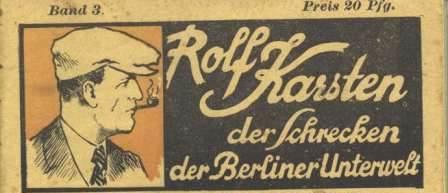 The German detective Rolf Karsten begins waging war on the criminals
of Berlin. He is a tough private detective who shows no mercy for those who
hurt others. (Rolf Karsten, der Schrecken der Berliner Unterwelt #1-6,
1930).
The German detective Rolf Karsten begins waging war on the criminals
of Berlin. He is a tough private detective who shows no mercy for those who
hurt others. (Rolf Karsten, der Schrecken der Berliner Unterwelt #1-6,
1930).
The female astronaut Aurore Lescure makes her first trip into space,
unfortunately bringing back an alien virus. The virus consumes electricity
and briefly wreaks havoc on Earth before it is destroyed. (Theo Varlet’s Aurore
Lescure novels, beginning with La Grande Panne, 1930).
The Indian adventurer “Rama Sahib” begins fighting crime in the “Black
Jungle” where once Sandokan traveled and fought. (Rama Sahib, La
Tigre della Jungla Nera).
 Rolf Torring, a German hunter in Africa, comes to the public’s attention.
He is primarily (though not exclusively) active in Africa, finding adventure
and helping many innocent men and women avoid danger and death. He is assisted
by his juvenile German water-carrier Hans Warren and by his enormous native
African friend “Pongo.” He is active for over twenty years and is suspiciously
unchanged and well-preserved in 1961, the date of his last known sighting.
(“Hans Warren”/Wilhelm & Hans Reinhard’s Rolf Torrings Abenteuer
#1-446, 1930-1939, and Rolf Torrings Reiseabenteuer, 1949-1961).
Rolf Torring, a German hunter in Africa, comes to the public’s attention.
He is primarily (though not exclusively) active in Africa, finding adventure
and helping many innocent men and women avoid danger and death. He is assisted
by his juvenile German water-carrier Hans Warren and by his enormous native
African friend “Pongo.” He is active for over twenty years and is suspiciously
unchanged and well-preserved in 1961, the date of his last known sighting.
(“Hans Warren”/Wilhelm & Hans Reinhard’s Rolf Torrings Abenteuer
#1-446, 1930-1939, and Rolf Torrings Reiseabenteuer, 1949-1961).
Tore Waller begins solving crimes. Waller, a Swede, is a brilliant,
independent engineer who inspires comparisons to Nietzsche’s übermenschen.
(August Jansson’s Tore Waller novels, beginning with Vändjärnsmordet,
1930).
Timeline: To
1800.
Timeline: 1801-1859.
Timeline: 1860-1900.
Timeline:
1901-1910.
Timeline:
1911-1920.
Timeline: 1931-1945.
Notes.
Some Unknown Members
of the Wold Newton Family Tree.
 The German detective Timm Fox begins work in Berlin. Although
he solves his share of murders, he also confronts and defeats a number
of fantastic opponents, including a “living holy picture,” a Sudanese vampire,
a cult engaging in human sacrifice, and a group of hostile Martians
(not the same race as the ones of London, 1898). Halfway through the year
he has a friendly competition with Nick Carter. (Timm Fox, der
Konig der Detektiv #1-48, 1921, and Aus den Geheimakten, Eines Weltdetektivs
#1-11, 1921).
The German detective Timm Fox begins work in Berlin. Although
he solves his share of murders, he also confronts and defeats a number
of fantastic opponents, including a “living holy picture,” a Sudanese vampire,
a cult engaging in human sacrifice, and a group of hostile Martians
(not the same race as the ones of London, 1898). Halfway through the year
he has a friendly competition with Nick Carter. (Timm Fox, der
Konig der Detektiv #1-48, 1921, and Aus den Geheimakten, Eines Weltdetektivs
#1-11, 1921).  The heroic German adventurer Harry Hill has a good year in
fighting and defeating evil around the world. (Harry Hill, der Weltmeister
der Sensationen #1-27,1921-1922).
The heroic German adventurer Harry Hill has a good year in
fighting and defeating evil around the world. (Harry Hill, der Weltmeister
der Sensationen #1-27,1921-1922).  In Berlin the criminal mastermind Dr. Mabuse begins working
toward world domination. He is a psychiatrist who uses his psychiatric knowledge
and abilities at hypnotism (he can also summon visions to control weaker personalities)
and disguise for his own nefarious ends. Among his other operations are counterfeiting
rings, gambling halls, brothels, murder rings, and kidnaping operations.
He is pursued by Police Inspector von Wenk. Mabuse gains his fortune by manipulating
the stock market, ruining the weak Count Told and exploiting Countess Told,
a "debauched thrill-seeking aristocrat." Mabuse also exploits his own girlfriend,
the ballerina Cara Carozza, who is nonetheless slavishly loyal to Mabuse.
Although Mabuse begins as something of an anti-hero, defying a decadent and
corrupt German society, he eventually becomes a thorough-going villain, and
he kills Cara to guarantee her silence (she'd been grilled by Countess Told
earlier but had refused to turn coat), kidnaps and tortures Countess Told,
and kills Count Told. Eventually Mabuse goes insane, haunted by the ghosts
of his victims, and is imprisoned in an asylum. That is not the end for Mabuse,
however.... (Norbert Jacques Dr. Mabuse stories and films, beginning with
Dr. Mabuse, Der Spieler, 1921).
In Berlin the criminal mastermind Dr. Mabuse begins working
toward world domination. He is a psychiatrist who uses his psychiatric knowledge
and abilities at hypnotism (he can also summon visions to control weaker personalities)
and disguise for his own nefarious ends. Among his other operations are counterfeiting
rings, gambling halls, brothels, murder rings, and kidnaping operations.
He is pursued by Police Inspector von Wenk. Mabuse gains his fortune by manipulating
the stock market, ruining the weak Count Told and exploiting Countess Told,
a "debauched thrill-seeking aristocrat." Mabuse also exploits his own girlfriend,
the ballerina Cara Carozza, who is nonetheless slavishly loyal to Mabuse.
Although Mabuse begins as something of an anti-hero, defying a decadent and
corrupt German society, he eventually becomes a thorough-going villain, and
he kills Cara to guarantee her silence (she'd been grilled by Countess Told
earlier but had refused to turn coat), kidnaps and tortures Countess Told,
and kills Count Told. Eventually Mabuse goes insane, haunted by the ghosts
of his victims, and is imprisoned in an asylum. That is not the end for Mabuse,
however.... (Norbert Jacques Dr. Mabuse stories and films, beginning with
Dr. Mabuse, Der Spieler, 1921).  Jack Mylong begins adventuring. He starred in movies under a variety
of names but was known in the German film industry of the 1920s as "Jack
Mylong-Münz." Like Harry Piel, he was a legitimate star in Europe in
the 1920s and 1930s, but unlike Piel Mylong saw the evils of the Nazi regime
and left Germany in 1935, emigrating to the United States. He resumed acting
in 1940 and worked in Hollywood for another twenty years, dying in 1975 at
the age of 83.
Jack Mylong begins adventuring. He starred in movies under a variety
of names but was known in the German film industry of the 1920s as "Jack
Mylong-Münz." Like Harry Piel, he was a legitimate star in Europe in
the 1920s and 1930s, but unlike Piel Mylong saw the evils of the Nazi regime
and left Germany in 1935, emigrating to the United States. He resumed acting
in 1940 and worked in Hollywood for another twenty years, dying in 1975 at
the age of 83.  The German detective and adventurer Fred Parker begins a
successful career of defending the oppressed against the oppressor wherever
Parker finds them. (Fred Parker, Die Erlebnisse des Großen Unbekannten
#1-152, 1921-1923).
The German detective and adventurer Fred Parker begins a
successful career of defending the oppressed against the oppressor wherever
Parker finds them. (Fred Parker, Die Erlebnisse des Großen Unbekannten
#1-152, 1921-1923).  1922. The American detective company Browning
and Co. opens for business, leading to many years of profitable and
successful work. (Jose Moselli’s Browning and Co. stories, beginning in
1922).
1922. The American detective company Browning
and Co. opens for business, leading to many years of profitable and
successful work. (Jose Moselli’s Browning and Co. stories, beginning in
1922).  The German adventurer Kurt Gafran begins a series of world-spanning
adventures. Gafran’s adventures take him from India to the Sahara to Mexico
to New York City to the Mediterranean to the Rif Desert to Sumatra and
all points in-between. (Kurt Gafrans Reiseabenteuer #1-56, 1922-1932)
The German adventurer Kurt Gafran begins a series of world-spanning
adventures. Gafran’s adventures take him from India to the Sahara to Mexico
to New York City to the Mediterranean to the Rif Desert to Sumatra and
all points in-between. (Kurt Gafrans Reiseabenteuer #1-56, 1922-1932) Miraculas, a French inventor-adventurer known as “the man of thousand
and one marvels,” begins a series of fabulous adventures around the world.
Miraculas’ base is an island laboratory on which he creates a range of
advanced technology. Some of his exploits involve a descent into a subterranean
world, the discovery of an undersea city claiming to be “Atlantis,” and
the successful resuscitation of a Neanderthal. (Gabriel Bernard’s Miraculas
#1-20, 1922).
Miraculas, a French inventor-adventurer known as “the man of thousand
and one marvels,” begins a series of fabulous adventures around the world.
Miraculas’ base is an island laboratory on which he creates a range of
advanced technology. Some of his exploits involve a descent into a subterranean
world, the discovery of an undersea city claiming to be “Atlantis,” and
the successful resuscitation of a Neanderthal. (Gabriel Bernard’s Miraculas
#1-20, 1922).  Eddy Polo (1875-1961) begins adventuring. Like Billy Jenkins
and Harry Piel, among others, Polo's career as an adventurer is obscured
or omitted by the mainstream history books. To film historians, Polo is only
an actor, albeit one of the giants of silent film, the "Hercules of the Screen."
He acted widely in the 1910s, although his appearances were more selective
in the 1920s and the arrival of sound in film began the end of his career.
Eddy Polo (1875-1961) begins adventuring. Like Billy Jenkins
and Harry Piel, among others, Polo's career as an adventurer is obscured
or omitted by the mainstream history books. To film historians, Polo is only
an actor, albeit one of the giants of silent film, the "Hercules of the Screen."
He acted widely in the 1910s, although his appearances were more selective
in the 1920s and the arrival of sound in film began the end of his career.
 1923. Luciano Albertini (1882-1945) begins adventuring.
Like Harry Piel and a number of other actors and actresses of the
1910s and 1920s, Albertini's career as an adventurer has been omitted by
film historians. Albertini was a legitimate superstar in European film in
the 1910s and 1920s, huge in Italy in the 1920s and then quite popular in
Germany in the 1920s. His career as an actor came to an end with the advent
of sound. But before he retired from film he saved the lives of a number
of men and women in a variety of adventures in quite varied settings. (Luciano
Albertini #1-16, 1923). Albertini may have been one of the “Celluloid
Adventurers;” see Note
#7.
1923. Luciano Albertini (1882-1945) begins adventuring.
Like Harry Piel and a number of other actors and actresses of the
1910s and 1920s, Albertini's career as an adventurer has been omitted by
film historians. Albertini was a legitimate superstar in European film in
the 1910s and 1920s, huge in Italy in the 1920s and then quite popular in
Germany in the 1920s. His career as an actor came to an end with the advent
of sound. But before he retired from film he saved the lives of a number
of men and women in a variety of adventures in quite varied settings. (Luciano
Albertini #1-16, 1923). Albertini may have been one of the “Celluloid
Adventurers;” see Note
#7.  Todd Marvel begins fighting crime. Marvel is a wealthy amateur detective,
but he takes his crimefighting far more seriously than other, similar individuals
such as Lord Peter Wimsey. Marvel’s arch-enemy is Karl Kristian,
an insane German surgeon who is known as “the King of Transplanting.” (Gustave
LeRouge’s Les Aventures de Todd Marvel, Détective Milliardaire
#1-20 in 1923 and L'Homme Libre, 1924). It is not known whether
Kristian studied under Dr. Caresco or Dr. Cornélius Kramm,
although the similarity between Kristian’s methods and those of Kramm make
some sort of relationship between them likely. However, it is extremely
unlikely that Kramm would have employed any interns.
Todd Marvel begins fighting crime. Marvel is a wealthy amateur detective,
but he takes his crimefighting far more seriously than other, similar individuals
such as Lord Peter Wimsey. Marvel’s arch-enemy is Karl Kristian,
an insane German surgeon who is known as “the King of Transplanting.” (Gustave
LeRouge’s Les Aventures de Todd Marvel, Détective Milliardaire
#1-20 in 1923 and L'Homme Libre, 1924). It is not known whether
Kristian studied under Dr. Caresco or Dr. Cornélius Kramm,
although the similarity between Kristian’s methods and those of Kramm make
some sort of relationship between them likely. However, it is extremely
unlikely that Kramm would have employed any interns.  1924. Carlo Aldini begins adventuring. The
Italian Aldini (1894-1961) did not act as widely as some of his predecessors,
but his energy and vigor easily transmitted themselves to the audience, and
Aldini was a star in Italy and Germany in the 1920s. A boxer and champion
wrestler, Aldini put his skills to use when he was not making films, traveling
around the world, hunting tigers, fighting pirates, going after female jewel
thieves, and the like. (Alfred Bienengraber’s Carlo Aldini, der tollkühne
Abenteurer #1-25, 1924). Aldini may have been one of the “Celluloid
Adventurers;” see Note
#7.
1924. Carlo Aldini begins adventuring. The
Italian Aldini (1894-1961) did not act as widely as some of his predecessors,
but his energy and vigor easily transmitted themselves to the audience, and
Aldini was a star in Italy and Germany in the 1920s. A boxer and champion
wrestler, Aldini put his skills to use when he was not making films, traveling
around the world, hunting tigers, fighting pirates, going after female jewel
thieves, and the like. (Alfred Bienengraber’s Carlo Aldini, der tollkühne
Abenteurer #1-25, 1924). Aldini may have been one of the “Celluloid
Adventurers;” see Note
#7.  The German master detective John Kling begins his decades-long
career of crimesolving by opening a consulting detective agency in Berlin.
He has certain similarities to Sherlock Holmes, including a Dr.
Watson-like friend, Jones Burthe, but Kling is far too secure in his own
identity to fall prey to the “Great Detective Syndrome”
and even has a long-time lover, Mary, something the misogynist Holmes was
never capable of. Over the course of his long career Kling takes on a
wide variety of enemies, occultists, "Satan," "Madame Satan," pretenders
to operetta kingdoms, and boxing champions; Kling finds a lost kingdom
of Mayans, is appointed King of another European operetta kingdom, investigates
Martian gold (though not the Martians of London, 1898), and encountered
the "Three-Eyed Buddha." (Welt Kriminal Bucherei #1-21, John
Kling's Abenteuer #22-35, Welt Kriminal Bucherei, #36-42, John
Kling's Abenteuer #43-592, 1924-1933 and then 1949-1954, John Kling's
Erinnerungen #1-215, 1931-1939, and John Kling Bucher #1-21,
1937-1939). (see also 1930).
The German master detective John Kling begins his decades-long
career of crimesolving by opening a consulting detective agency in Berlin.
He has certain similarities to Sherlock Holmes, including a Dr.
Watson-like friend, Jones Burthe, but Kling is far too secure in his own
identity to fall prey to the “Great Detective Syndrome”
and even has a long-time lover, Mary, something the misogynist Holmes was
never capable of. Over the course of his long career Kling takes on a
wide variety of enemies, occultists, "Satan," "Madame Satan," pretenders
to operetta kingdoms, and boxing champions; Kling finds a lost kingdom
of Mayans, is appointed King of another European operetta kingdom, investigates
Martian gold (though not the Martians of London, 1898), and encountered
the "Three-Eyed Buddha." (Welt Kriminal Bucherei #1-21, John
Kling's Abenteuer #22-35, Welt Kriminal Bucherei, #36-42, John
Kling's Abenteuer #43-592, 1924-1933 and then 1949-1954, John Kling's
Erinnerungen #1-215, 1931-1939, and John Kling Bucher #1-21,
1937-1939). (see also 1930).  Harold Lloyd begins adventuring. Lloyd (1893-1971) was one of the
two or three most famous stars of the silent era and was a landmark actor
and producer, worthy of comparison with Chaplin and Keaton. Lloyd's films
have weathered the passing of time and are as enjoyable today as they were
when they were first made. Like many other silent film stars, the advent
of sound marked the beginning of the end of his career as an actor. But Lloyd
had a secret, something few knew about: he spent a significant portion of
his personal time fighting crime and evil wherever he found it, both in America
and Europe. Like Harry Piel and several other film stars, Lloyd was
a hero, if not quite on the level of Nick Carter. (Harold Lloyd
#1-5, 1924). Lloyd may have been one of the “Celluloid Adventurers;” see
Note #7.
Harold Lloyd begins adventuring. Lloyd (1893-1971) was one of the
two or three most famous stars of the silent era and was a landmark actor
and producer, worthy of comparison with Chaplin and Keaton. Lloyd's films
have weathered the passing of time and are as enjoyable today as they were
when they were first made. Like many other silent film stars, the advent
of sound marked the beginning of the end of his career as an actor. But Lloyd
had a secret, something few knew about: he spent a significant portion of
his personal time fighting crime and evil wherever he found it, both in America
and Europe. Like Harry Piel and several other film stars, Lloyd was
a hero, if not quite on the level of Nick Carter. (Harold Lloyd
#1-5, 1924). Lloyd may have been one of the “Celluloid Adventurers;” see
Note #7.  Lee Parry begins adventuring. The German Parry (1901-1977) was born
"Hilde Benz" and began acting in the 1910s. It was only in 1920 that she
became a star in Europe. Like other silent film stars she was not made for
sound, and her star faded in the 1930s, after which she moved to South America
and became a star in theater. However, Parry had a secret: like Harry
Piel and Harold Lloyd, she made use of her spare time to help
others in the most direct way possible: through fighting crime and evil.
More so than most celebrity adventurers, however, she was active around the
world, from Mont-Martre to Upsala to the Rif desert to Whitechapel, and she
fought a variety of unusual opponents, from the Lady In Black to the Smiling
Muslim to the "Death Club," and she made several good friends, including
the Gypsy Princess and the White Knight. (Rosenhain & Hain’s Lee Parry--Die
tollkühne Abenteuerin #1-35, 1924). Parry may have been one of
the “Celluloid Adventurers;” see Note #7.
Lee Parry begins adventuring. The German Parry (1901-1977) was born
"Hilde Benz" and began acting in the 1910s. It was only in 1920 that she
became a star in Europe. Like other silent film stars she was not made for
sound, and her star faded in the 1930s, after which she moved to South America
and became a star in theater. However, Parry had a secret: like Harry
Piel and Harold Lloyd, she made use of her spare time to help
others in the most direct way possible: through fighting crime and evil.
More so than most celebrity adventurers, however, she was active around the
world, from Mont-Martre to Upsala to the Rif desert to Whitechapel, and she
fought a variety of unusual opponents, from the Lady In Black to the Smiling
Muslim to the "Death Club," and she made several good friends, including
the Gypsy Princess and the White Knight. (Rosenhain & Hain’s Lee Parry--Die
tollkühne Abenteuerin #1-35, 1924). Parry may have been one of
the “Celluloid Adventurers;” see Note #7.  The adventurous French Boy Scout Franc-Hardi begins a world-spanning
series of his adventures on the "radio plane" of the inventor-engineer
Korridès. (Jean de la Hire’s Les Grandes Aventures d'un
Boy-Scout #1-18, 1926).
The adventurous French Boy Scout Franc-Hardi begins a world-spanning
series of his adventures on the "radio plane" of the inventor-engineer
Korridès. (Jean de la Hire’s Les Grandes Aventures d'un
Boy-Scout #1-18, 1926).  The Turkish detective known as “Recai” begins a decades-long
career of independent crimesolving in Turkey and Europe. Known as “Cingöz
Recai” (“Wily Recai”), Recai is a cunning and devious detective influenced
in some respects by Arsène Lupin. Recai is a master of disguise,
full of Lupin's joie de vivre and good humour, and he does things as
much for the thrill of the chase as for any desire for justice. (“Server
Bedi”/Peyami Safa’s Recai novles, beginning with Alnimin kara yazisi
: roman, 1926). (see also 1940 below).
The Turkish detective known as “Recai” begins a decades-long
career of independent crimesolving in Turkey and Europe. Known as “Cingöz
Recai” (“Wily Recai”), Recai is a cunning and devious detective influenced
in some respects by Arsène Lupin. Recai is a master of disguise,
full of Lupin's joie de vivre and good humour, and he does things as
much for the thrill of the chase as for any desire for justice. (“Server
Bedi”/Peyami Safa’s Recai novles, beginning with Alnimin kara yazisi
: roman, 1926). (see also 1940 below).  1927. The mesmerist Loke Klingsor begins his criminal
career in Berlin. Known as “the Man With the Devil’s Eyes,” Klingsor clearly
models himself on Dr. Nikola but is not as successful as Nikola. (Robert
Kraft’s Loke Klingsor, Der Mann mit der Teufelsagen, 1927). It is not
known what relationship, if any, lies between Klingsor and Nikola.
1927. The mesmerist Loke Klingsor begins his criminal
career in Berlin. Known as “the Man With the Devil’s Eyes,” Klingsor clearly
models himself on Dr. Nikola but is not as successful as Nikola. (Robert
Kraft’s Loke Klingsor, Der Mann mit der Teufelsagen, 1927). It is not
known what relationship, if any, lies between Klingsor and Nikola.  The German adventurer Harry Pitt begins fighting crime around the
world, combating masked crime leaders and Satanic cults in the United States,
England, and Europe. (Harry Pitt's Abenteuer #1-25, 1927).
The German adventurer Harry Pitt begins fighting crime around the
world, combating masked crime leaders and Satanic cults in the United States,
England, and Europe. (Harry Pitt's Abenteuer #1-25, 1927).  The great German detective Tom Shark begins a decades-long career
as the “King of Detectives.” Shark is successful both in Germany and Europe
and the rest of the world, solving both ordinary crimes and unusual and even
supernatural wickedness. His opponents range from ordinary, tawdry murderers
to villains the like of which Sexton Blake fought, from mad scientists
to master criminals. His activities during World War Two are unknown, although
it is assumed that he served in the German army, but after the war ended he
resumed work as a private detective in Berlin. (“Pitt Strong”/Elisabeth von
Aspern’s Tom Shark, der König der Detektivs #1-553, 1928-1939,
and #1-60, 1945-1951).
The great German detective Tom Shark begins a decades-long career
as the “King of Detectives.” Shark is successful both in Germany and Europe
and the rest of the world, solving both ordinary crimes and unusual and even
supernatural wickedness. His opponents range from ordinary, tawdry murderers
to villains the like of which Sexton Blake fought, from mad scientists
to master criminals. His activities during World War Two are unknown, although
it is assumed that he served in the German army, but after the war ended he
resumed work as a private detective in Berlin. (“Pitt Strong”/Elisabeth von
Aspern’s Tom Shark, der König der Detektivs #1-553, 1928-1939,
and #1-60, 1945-1951).  1929. The Swedish adventurer Olaf Karl Abelsen is
convicted of a crime he did not commit. He immediately escapes from prison
and goes on the run, fighting for justice both across Scandinavia and around
the run, accompanied by only one companion, his dog. His adventures quickly
become fantastic in scope, from the supernatural to the science fictional.
(“Max Schraut”/Walther Kabel’s Olaf K. Abelsen - Abseits der Alltagswege
#1-50, 1929-1933). (see also 1933 below).
1929. The Swedish adventurer Olaf Karl Abelsen is
convicted of a crime he did not commit. He immediately escapes from prison
and goes on the run, fighting for justice both across Scandinavia and around
the run, accompanied by only one companion, his dog. His adventures quickly
become fantastic in scope, from the supernatural to the science fictional.
(“Max Schraut”/Walther Kabel’s Olaf K. Abelsen - Abseits der Alltagswege
#1-50, 1929-1933). (see also 1933 below). Tintin, a teenaged Belgian, begins a decades-long career of extraordinary
exploits. He works as a reporter for Le Petit Vingtieme, traveling
around the world in pursuit of stories. He usually gets involved in the stories
he reports on, helping people and seeing that the wicked and criminal are
punished. He goes everywhere, from America, to the Congo, the Mediterranean,
Egypt, India, South America, Scotland, Tibet, and the moon itself. He is accompanied
by his faithful dog, the fox terrier Milou (who speaks to the reader), Dupont
and Dupond, a mustachioed pair of French detectives, Captain Haddock, a strong,
alcoholic sea captain, and Professor Tournesol, the deaf, dithery, eccentric
(but brilliant) scientist, whose inventions (a new white rose, an anti-alcohol
tablet, a mini-sub, a moon rocket, an "ultra-sound emitter," and high-speed
roller skates) enrich Tintin enough that he, Haddock, and Milou are able
to move in to a castle together. ("Hergé"/Georges Remi's Tintin stories,
beginning with Tintin aux Pays des Soviets, 1929).
Tintin, a teenaged Belgian, begins a decades-long career of extraordinary
exploits. He works as a reporter for Le Petit Vingtieme, traveling
around the world in pursuit of stories. He usually gets involved in the stories
he reports on, helping people and seeing that the wicked and criminal are
punished. He goes everywhere, from America, to the Congo, the Mediterranean,
Egypt, India, South America, Scotland, Tibet, and the moon itself. He is accompanied
by his faithful dog, the fox terrier Milou (who speaks to the reader), Dupont
and Dupond, a mustachioed pair of French detectives, Captain Haddock, a strong,
alcoholic sea captain, and Professor Tournesol, the deaf, dithery, eccentric
(but brilliant) scientist, whose inventions (a new white rose, an anti-alcohol
tablet, a mini-sub, a moon rocket, an "ultra-sound emitter," and high-speed
roller skates) enrich Tintin enough that he, Haddock, and Milou are able
to move in to a castle together. ("Hergé"/Georges Remi's Tintin stories,
beginning with Tintin aux Pays des Soviets, 1929). The eccentric dandy and juge d’instruction for the Paris police Henri
Bencolin comes to the public’s attention. Though a police officer Bencolin
often works on the side as a private investigator, charging exorbitant fees
that are greater than his official salary. He is very flamboyant and a regular
at certain nightclubs, where he is regularly seen drinking beer, smoking cigars,
and listening to jazz from a corner table. More importantly, though, he is
known as the “foremost police official in Europe and as the “most dangerous
man in Europe.” It is widely said about him that when he is looking only for
pleasure, he wears a plain sack suit. When he is thinking about a case he
is working on, he wears a dinner jacket. But when he has found the culprit
and is about to capture him or her, Bencolin wears evening clothes and carries
his walking stick with the silver head, inside of which is concealed a sword
blade. This story is true. Bencolin encourages his Watson, a young journalist
named Jeff Marle, to spread this story. Bencolin is known, with good reason,
as "Mephistopheles smoking a cigar," and though often challenged by his old
rival, the German Baron Sigismund von Arnheim, also triumphs. (John Dickson
Carr’s Henri Bencolin novels, beginning with It Walks By Night, 1930).
The eccentric dandy and juge d’instruction for the Paris police Henri
Bencolin comes to the public’s attention. Though a police officer Bencolin
often works on the side as a private investigator, charging exorbitant fees
that are greater than his official salary. He is very flamboyant and a regular
at certain nightclubs, where he is regularly seen drinking beer, smoking cigars,
and listening to jazz from a corner table. More importantly, though, he is
known as the “foremost police official in Europe and as the “most dangerous
man in Europe.” It is widely said about him that when he is looking only for
pleasure, he wears a plain sack suit. When he is thinking about a case he
is working on, he wears a dinner jacket. But when he has found the culprit
and is about to capture him or her, Bencolin wears evening clothes and carries
his walking stick with the silver head, inside of which is concealed a sword
blade. This story is true. Bencolin encourages his Watson, a young journalist
named Jeff Marle, to spread this story. Bencolin is known, with good reason,
as "Mephistopheles smoking a cigar," and though often challenged by his old
rival, the German Baron Sigismund von Arnheim, also triumphs. (John Dickson
Carr’s Henri Bencolin novels, beginning with It Walks By Night, 1930).
 The German detective Rolf Karsten begins waging war on the criminals
of Berlin. He is a tough private detective who shows no mercy for those who
hurt others. (Rolf Karsten, der Schrecken der Berliner Unterwelt #1-6,
1930).
The German detective Rolf Karsten begins waging war on the criminals
of Berlin. He is a tough private detective who shows no mercy for those who
hurt others. (Rolf Karsten, der Schrecken der Berliner Unterwelt #1-6,
1930).  Rolf Torring, a German hunter in Africa, comes to the public’s attention.
He is primarily (though not exclusively) active in Africa, finding adventure
and helping many innocent men and women avoid danger and death. He is assisted
by his juvenile German water-carrier Hans Warren and by his enormous native
African friend “Pongo.” He is active for over twenty years and is suspiciously
unchanged and well-preserved in 1961, the date of his last known sighting.
(“Hans Warren”/Wilhelm & Hans Reinhard’s Rolf Torrings Abenteuer
#1-446, 1930-1939, and Rolf Torrings Reiseabenteuer, 1949-1961).
Rolf Torring, a German hunter in Africa, comes to the public’s attention.
He is primarily (though not exclusively) active in Africa, finding adventure
and helping many innocent men and women avoid danger and death. He is assisted
by his juvenile German water-carrier Hans Warren and by his enormous native
African friend “Pongo.” He is active for over twenty years and is suspiciously
unchanged and well-preserved in 1961, the date of his last known sighting.
(“Hans Warren”/Wilhelm & Hans Reinhard’s Rolf Torrings Abenteuer
#1-446, 1930-1939, and Rolf Torrings Reiseabenteuer, 1949-1961).